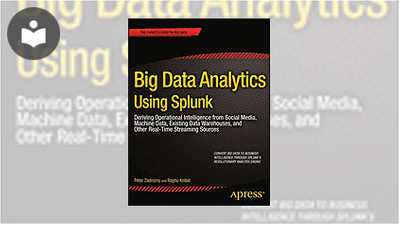Big Data Analytics Using Splunk
- 6h 20m
- Peter Zadrozny, Raghu Kodali
- Apress
- 2013
Big Data Analytics Using Splunk is a hands-on book showing how to process and derive business value from big data in real time. Examples in the book draw from social media sources such as Twitter (tweets) and Foursquare (check-ins). You also learn to draw from machine data, enabling you to analyze, say, web server log files and patterns of user access in real time, as the access is occurring. Gone are the days when you need be caught out by shifting public opinion or sudden changes in customer behavior. Splunk’s easy to use engine helps you recognize and react in real time, as events are occurring.
Splunk is a powerful, yet simple analytical tool fast gaining traction in the fields of big data and operational intelligence. Using Splunk, you can monitor data in real time, or mine your data after the fact. Splunk’s stunning visualizations aid in locating the needle of value in a haystack of a data. Geolocation support spreads your data across a map, allowing you to drill down to geographic areas of interest. Alerts can run in the background and trigger to warn you of shifts or events as they are taking place.
With Splunk you can immediately recognize and react to changing trends and shifting public opinion as expressed through social media, and to new patterns of eCommerce and customer behavior. The ability to immediately recognize and react to changing trends provides a tremendous advantage in today’s fast-paced world of Internet business. Big Data Analytics Using Splunk opens the door to an exciting world of real-time operational intelligence.
- Built around hands-on projects
- Shows how to mine social media
- Opens the door to real-time operational intelligence
What you’ll learn
- Monitor and mine social media for trends affecting your business
- Know how you are perceived, and when that perception is rising or falling
- Detect changing customer behavior from mining your operational data
- Collect and analyze in real time, or from historical files
- Apply basic analytical metrics to better understand your data
- Create compelling visualizations and easily communicate your findings
Who this book is for
Big Data Analytics Using Splunk is for those who are interested in exploring the heaps of data they have available, but don’t know where to start. It is for the people who have knowledge of the data they want to analyze and are developers or SQL programmers at a level anywhere between beginners and intermediate. Expert developers also benefit from learning how to use such a simple and powerful tool as Splunk.
About the Authors
Peter Zadrozny is an independent consultant specialized in big data, software performance, and architecture. He is also a lecturer on big data topics at San Jose State University. He has held various executive and technical roles in many countries around the world for startups as well as Fortune 500 companies. He started the operations of WebLogic in Europe and Sun Microsystems in Mexico. He is an accomplished author with various successful books, a magazine, and was an original contributor to The Grinder, a popular open source project.
Raghu Kodali isvice president of Product Management & Strategy at Solix Technologies, where he is responsible for product vision, management, strategy, user design, and interaction. His work includes the next-generation data optimization platform, industry-leading data discovery platform, enterprise data management-as-a-service, application development using Big Data platforms and cloud. Prior to Solix he was with Oracle for 12 years, holding senior management positions responsible for Product Management & Strategy for Oracle Fusion Middleware products. In addition, Raghu was Oracle's SOA Evangelist leading next-generation Java EE initiatives. Raghu has authored a leading technical reference on Java computing, Beginning EJB 3 Application Development: From Novice to Professional (Apress, 2006), published numerous articles on enterprise technologies and was a contributing author for Oracle Information Integration, Migration and Consolidation (PACKT Publishing, 2011).
In this Book
-
Big Data and Splunk
-
Getting Data into Splunk
-
Processing and Analyzing the Data
-
Visualizing the Results
-
Defining Alerts
-
Web Site Monitoring
-
Using Log Files to Create Advanced Analytics
-
The Airline On-Time Performance Project
-
Getting the Flight Data into Splunk
-
Analyzing Airlines, Airports, Flights, and Delays
-
Analyzing a Specific Flight Over the Years
-
Analyzing Tweets
-
Analyzing Foursquare Check-Ins
-
Sentiment Analysis
-
Remote Data Collection
-
Scaling and High Availability






